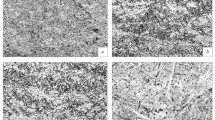Conclusion
Alloys VT3-1, VT22, and VT15 can be deformed by hydrostatic extrusion at room temperature. The deformability of alloy VT22 is highest. Quenching from 700–750° and hydrostatic extrusion with 20–30% deformation + aging at 500–550° for 1–2 h produces the optimal combination of high strength and good ductility.
Similar content being viewed by others
Literature cited
B. I. Beresnev et al., Ductility and Strength of Solids at High Pressures [in Russian], Nauka, Moscow (1970), p. 38.
V. N. Moiseev, "Basic prerequisites for creating high-strength titanium alloys with α+β structure by alloying and heat treatment," in: Metal Science of Titanium [in Russian], Nauka, Moscow (1964), p. 165.
Additional information
Translated from Metallovedenie i Termicheskaya Obrabotka Metallov, No. 3, pp. 74–76, March, 1976.
Rights and permissions
About this article
Cite this article
Legkodukh, A.M., Korostelev, Y.P., Pribylova, V.I. et al. Properties of high-strength titanium alloys after hydrostatic extrusion. Met Sci Heat Treat 18, 276–278 (1976). https://doi.org/10.1007/BF00663501
Issue Date:
DOI: https://doi.org/10.1007/BF00663501




